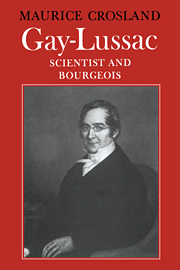Book contents
- Frontmatter
- Contents
- Preface
- Chronological table
- List of abbreviations
- 1 A young provincial in Paris
- 2 The apprentice of Arcueil
- 3 Personal influences and the search for laws
- 4 Collaboration and rivalry
- 5 The volumetric approach
- 6 Scientific research
- 7 Professor, Academician and editor
- 8 A scientist in the service of government and industry
- 9 A new technique and the dissemination of technical information
- 10 Scientist and bourgeois in the political arena
- 11 The legacy
- Appendix: select correspondence
- Notes
- Select bibliography
- Name index
- Subject index
6 - Scientific research
Published online by Cambridge University Press: 03 November 2009
- Frontmatter
- Contents
- Preface
- Chronological table
- List of abbreviations
- 1 A young provincial in Paris
- 2 The apprentice of Arcueil
- 3 Personal influences and the search for laws
- 4 Collaboration and rivalry
- 5 The volumetric approach
- 6 Scientific research
- 7 Professor, Academician and editor
- 8 A scientist in the service of government and industry
- 9 A new technique and the dissemination of technical information
- 10 Scientist and bourgeois in the political arena
- 11 The legacy
- Appendix: select correspondence
- Notes
- Select bibliography
- Name index
- Subject index
Summary
‘One should not be miserly either with one's time or care’
Gay-LussacScientific productivity
An appropriate place for an assessment of Gay-Lussac's contributions to science is at the end of a book rather than in the middle and this chapter therefore is concerned rather to outline the range of Gay-Lussac's scientific work, which is far wider than one might think, since it extends not only from the most theoretical to the most practical but also covers a spread of subject matter ranging from physics through chemistry to physiology. We will begin with the physical end of the spectrum, which is where Gay-Lussac himself began after his mathematical training at the Ecole Polytechnique and his association with Laplace, culminating in institutional recognition as a member of the physics section of the Institute. The label of physicist, however, seems increasingly inappropriate as Gay-Lussac's work became almost exclusively chemical.
Before considering the details of various aspects of Gay-Lussac's work it might be useful to consider his productivity over his whole career. He published approximately 150 papers which appeared under his own name alone and about thirty joint papers with a variety of collaborators. It may be of interest to present the publication of these papers against a scale of Gay-Lussac's life span, omitting the first twenty-two years, when, understandably, he published nothing. Fig. 2, therefore, begins in the year 1800. One of the dangers of attempting to quantify scientific genius is that any representation may be interpreted in absolute terms.
- Type
- Chapter
- Information
- Gay-LussacScientist and Bourgeois, pp. 115 - 142Publisher: Cambridge University PressPrint publication year: 1978



